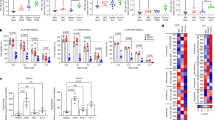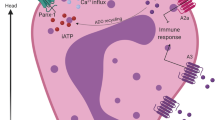Abstract
The lysis of tumor cells, and other nucleated mammalian cells, by neutrophilic polymorphonuclear leukocytes (PMNs) triggered by phorbol myristate acetate (PMA) represents a widely used model system to dissect the PMN cytolytic armamentarium, potentially responsible for the cell damage at tissue sites of PMN activation. Although oxidants are generally considered to be instrumental in the target lysis by PMNs, the mediators actually involved remain a matter of controversy. Moreover, other factors potentially crucial to the lysis have not been clearly identified. In order to reexamine the determinants of the cytolytic process, we studied the events underlying the PMA-triggered PMN-delivered attack against two different targets, selected on the basis of preliminary experiments (B lymphoblastoid Daudi cells and erythroleukemic K 562 cells). The results suggest that the lysis is promoted by hypochlorous acid (HOCl) or a compound with characteristics very similar to HOCl itself. No evidence was obtained for the intervention or contribution of hydrogen peroxide (H2O2), hydroxyl (OH ·) radicals, and the major HOCl-derived chloramines. PMNs appeared to use 35% of the generated H2O2 to produce HOCl, while the remainder appears to be consumed by PMNs themselves and target cells as well. Moreover, PMNs and target cells coaggregated at an early step of the cytolytic reaction, through a process efficiently prevented by a monoclonal antibody (MoAb J-90) directed against leukocyte function-associated antigen-1 (LFA-1). The inhibition of the PMN-target aggregation by the MoAb J-90 resulted in the impairment of the lysis, despite a normal generation of HOCl. Thus, the data demonstrate that the PMA-triggered lysis of tumor target cells by PMNs requires at least two events, occurring simultaneously: the LFA-1-mediated effector-target adherence and the PMN production of HOCl. The intervention of the LFA-1-mediated PMN-target adherence in the PMA-triggered lysis is likely to allow PMNs to focus HOCl on the target cell surface and suggests that the process requires a sort of molecule to molecule recognition at the effector-target surface level.
Similar content being viewed by others
References
Weiss, S. J., andA. F. Lo Buglio. 1982. Phagocyte-generated oxygen metabolites and cellular injury.Lab. Invest. 47:15–18.
Clark, R. A. 1983. Extracellular effects of the myeloperoxidase-hydrogen peroxide-halide system.Adv. Inflamm. Res. 5:107–146.
Becker, E. L. 1988. The cytotoxic action of neutrophils mammalian cells in vitro.Prog. Allergy 40:183–208.
Lichtenstein, A. 1988. Neutrophil-mediated nonoxidative tumor lysis stimulated by high concentrations of phorbol myristate acetate.Clin. Immunol. Immunopathol. 47:296–309.
Clark, R. A. andS. Szot. 1981. The myeloperoxidase-hydrogen peroxide-halide system as effector of neutrophil-mediated tumor cell cytotoxicity.J. Immunol. 126:1295–1301.
Weiss, S. J., andA. Slivka. 1982. Monocyte and granulocyte-mediated tumor cell destruction. A role for the hydrogen peroxide-myeloperoxidase-chloride system.J. Clin. Invest. 69:255–262.
English, D., andJ. N. Lukens. 1983. Regulation of neutrophil inflammatory mediator release: Chemotactic peptide activation of stimulus-dependent cytotoxicity.J. Immunol. 130:850–856.
Aune, T. M., andE. L. Thomas. 1977. Accumulation of hypothiocyanite ion during peroxidase-catalyzed oxidation of thiocyanate ion.Eur. J. Biochem. 80:209–214.
Dallegri, F., F. Patrone, A. Ballestrero, G. Frumento, andC. Sacchetti. 1986. Inhibition of neutrophil cytolysin production by target cells.Blood 67:1265–1272.
Thomas, E. L., M. M. Jefferson, andM. B. Grisham. 1982. Myeloperoxidase-catalyzed incorporation of amines into proteins: Role of hypochlorous acid and dichloramines.Biochemistry 21:2699–2708.
Grisham, M. B., M. M. Jefferson, andE. L. Thomas. 1984. Role of monochloramine in the oxidation of erythrocyte hemoglobin by stimulated neutrophils.J. Biol. Chem. 259:6757–6765.
Dallegri, F., R. Goretti, A. Ballestrero, L. Ottonello, andF. Patrone. 1988. Neutrophil-induced depletion of adenosine triphosphate in target cells: Evidence for a hypochlorous acid-mediated process.J. Lab Clin. Med. 112:762–772.
Zocchi, M. R., C. Bottino, S. Ferrini, L. Moretta, andA. Moretta. 1987. A novel 120-kD surface antigen expressed by a subset of human lymphocytes. Evidence that lymphokineactivated killer cells express this molecule and use it in their effector function.J. Exp. Med. 166:319–326.
Dankberg, F., andM. A. Persidsky. 1976. A test of granulocyte membrane integrity and phagocytic function.Cryobiology 13:430–435.
Ruch, W., P. H. Cooper, andM. Baggiolini. 1983. Assay of H2O2 production by macrophages and neutrophils with homovanillic acid and horse-radish peroxidase.J. Immuno. Methods 63:347–357.
Test, S. T., andS. J. Weiss. 1984. Quantitative and temporal characterization of the extracellular H2O2 pool generated by human neutrophils.J. Biol. Chem. 259:339–405.
Weiss, S. J., R. Klein, A. Slivka, andM. Wei. 1982. Chlorination of taurine by human neutrophils. Evidence for hypochlorous acid generation.J. Clin. Invest. 70:598–607.
Winterburn, C. C. 1986. Myeloperoxidase as an effective inhibitor of hydroxyl radical production. Implications for the oxidative reactions of neutrophils.J. Clin. Invest. 78:545–550.
Rothlein, R., M. L. Dustin, S. D. Marlin, andT. A. Springer. 1986. A human intercellular adhesion molecule (ICAM-1) distinct from LFA-1.J. Immunol. 137:1270–1274.
Dallegri, F., F. Patrone, G. Frumento, A. Ballestrero, andC. Sacchetti. 1985. Downregulation of K cell activity by neutrophils.Blood 65:571–577.
Grisham, M. B., M. M. Jefferson, D. F. Melton, andE. L. Thomas. 1984. Chlorination of endogenous amines by isolated neutrophils: Ammonia-dependent bactericidal, cytotoxic and cytolytic activities of the chloramines.J. Biol. Chem. 259:10404–10413.
Beutler, E. 1984. Red Cell Metabolism. A Manual of Biochemical Methods. Grune & Stratton, Orlando.
Halliwell, B., andJ. M. G. Gutteridge. 1986. Oxygen free radicals and iron in relation to biology and medicine: Some problems and concepts.Arch. Biochem. Biophys. 246:501–514.
Test, S. T., andS. J. Weiss. 1986. The generation and utilization of chlorinated oxidands by human neutrophils.Adv. Free Radical Biol. Med. 2:91–116.
Thomas, E. L., M. B. Grisham, andM. M. Jefferson. 1983. Myeloperoxidase-dependent effect of amines on functions of isolated neutrophils.J. Clin. Invest. 72:441–454.
Nauseef, W. M., J. A. Metcalf, andR. K. Root. 1983. Role of myeloperoxidase in the respiratory burst of human neutrophils.Blood 61:483–492.
Dallegri, F., G. Frumento, andF. Patrone. 1983. Mechanisms of tumor cell destruction by PMA-activated human neutrophils.Immunology 48:273–279.
Weissmann, G, J. E. Smolen, andH. M. Korchak. 1980. Release of inflammatory mediators from stimulated neutrophils.N. Engl. J. Med. 303:27–34.
Higgins, C. P., R. L. Bachner, J. McCallister, andL. A. Boxer. 1978. Polymorphonuclear leukocyte species differences in the disposal of hydrogen peroxide.Proc. Soc. Exp. Biol. Med. 158:478–481.
Athen, C. F., B. A. Arrick, H. W. Murray, N. M. De Santis, andZ. A. Cohn. 1980. Tumor cell anti-oxidant defences.J. Exp. Med. 153:766–782.
Weiss, S. J., J. Young, A. Lo Buglio, A. Slivka, andN. F. Nimeh. 1981. Role of hydrogen peroxide in neutrophil-mediated destruction of cultured endothelial cells.J. Clin. Invest. 68:714–721.
Vedder, N. B., andJ. M. Harlan. 1988. Increased surface expression of CD1 1b/CD18 (Mac- 1) is not required for stimulated neutrophil adherence to cultured endothelium.J. Clin. Invest. 81:676–682.
Anderson, D. C., andT. A. Springer. 1987. Leukocyte adhesion deficiency: and inherited defect in the Mac-1, LFA-1, and p 150,95 glycoproteins. Annu. Rev. Med.38:175–194.
Kohl, S., T. A. Springer, F. C. Schmalstieg, L. S. Loo, andD. C. Anderson. 1984. Defective natural killer cytotoxicity and polymorphonuclear leukocyte antibody-dependent cellular cytotoxicity in patients with LFA-1/OKM-1 deficiency.J. Immunol. 133:2972–2978.
Kurzinger, K., M. K. Ho, andT. A. Springer. 1982. Structural homology between Mac-1 as a macrophage differentiation antigen and LFA-1, an antigen that participates in T lymphocyte mediated killing,Nature 296:668.
Ferrini, S., S. Miescher, M. R. Zocchi, V. Von Fliedner, andA. Moretta. 1987. Phenotypic and functional characterization of recombinant interleukin 2 (rIL-2)-induced activated killer cells: Analysis at the population and clonal levels.J. Immunol. 138:1297–1302.
Strassmann, G., T. A. Springer, S. D. Somers, andD. O. Adams. 1986. Mechanisms of tumor cell capture by activated macrophages: Evidence for involvement of lymphocyte function-associated (LFA)-1 antigen.J. Immunol. 136:4328–4333.
Author information
Authors and Affiliations
Additional information
Supported by grants from Italian C.N.R. and M.P.I. Dr. Luciano Ottonello is a recepient of a Fellowship from C.N.R.
Rights and permissions
About this article
Cite this article
Dallegri, F., Ottonello, L., Ballestrero, A. et al. Tumor cell lysis by activated human neutrophils: Analysis of neutrophil-delivered oxidative attack and role of leukocyte function-associated antigen 1. Inflammation 15, 15–30 (1991). https://doi.org/10.1007/BF00917906
Issue Date:
DOI: https://doi.org/10.1007/BF00917906




